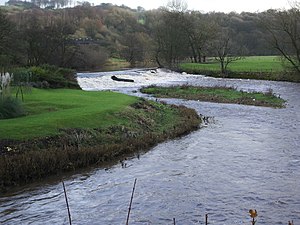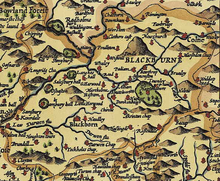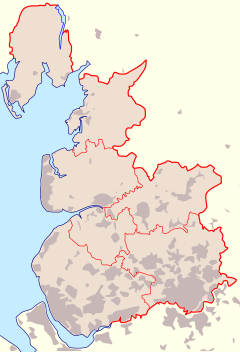Blackburnshire

Blackburnshire or the Hundred of Blackburn is one of the six hundreds of Lancashire. Its chief town, after which it is named, is Blackburn, in the north-west of the hundred. Blackburnshire covers an area of eastern Lancashire including much of the Ribble Valley and the towns of Accrington, Bacup, Blackburn and Burnley. It has a total population of 515,114 which ranks it third behind Salfordshire and West Derby in decreasing order of population.
Much of the area is hilly, bordering on the Pennines, with Pendle Hill in the midst of it, and until the Industrial Revolution it was sparsely populated. In the Middle Ages much of the hundred was within several important royal forests. In the 18th century, several towns in the area became industrialised and densely populated.
History
In Domesday Book of 1086, the Hundred of Blackburn was among the hundreds between the Rivers Ribble and Mersey, which area was called Inter Ripam et Mersam and listed alongside the Cheshire entries, although local historians conclude that this area cannot be said clearly to have then been considered part of Cheshire.[1][2][3]
At Domesday the area was predominantly woodland, and was known as the great forest of Blackburnshire. Domesday states the forest to be 6 leagues long and 4 leagues wide, which could be as much as 216 square miles. It also shows that the land had been held directly by King Edward.[4] After the Norman conquest, much of the great forest was established as royal hunting grounds, and was divided into the four forests of Accrington, Pendle, Trawden and Rossendale.[5]
Feudal period
In 1102, King Henry I granted the whole of Blackburnshire and part of Amounderness to Robert de Lacy, the Lord of Pontefract, while confirming his possession of the Lordship of Bowland.[6] These lands formed the basis of the Honour of Clitheroe. Subsequently most of the parish of Ribchester, except the township of Alston-with-Hothersall, and in the parish of Chipping, vills of Aighton and Dutton and parts edging the Forest of Bowland belonging ecclesiastically to the parish of Great Mitton were annexed to Blackburnshire.[5]
The separateness of the district was reinforced when it became a royal bailiwick in 1122. In 1182, it was included as part of Lancashire, apparently then newly created as a county.
By 1243 it is believed that there were 57 manors in the hundred:
- Held in demesne were: Colne, Great and Little Marsden, Briercliffe, Burnley, Ightenhill, Habergham, Padiham, Huncoat, Hapton, Accrington, Haslingden, Downham, Worston, Chatburn and Little Pendleton.[5]
- Held by thegnage were: Twiston, Chipping, Thornley, Wheatley, Ribchester, Dutton, Dinckley, Henthorn, Wilpshire, Clayton-le-Dale, Salesbury, Osbaldeston, Samlesbury, Read, Simonstone, Oswaldtwistle, Livesey, Birtwistle, Church, Cliviger and Worsthorne.[5]
- Held by knight's service were: Little Mitton, Wiswell, Hapton, Towneley, Coldcoats, Snodworth, Twiston, Extwistle, Aighton, Great Mearley, Livesey, Downham, Foulridge, Little Mearley, Rishton, Billington, Altham, Great Harwood, Clayton le Moors, and Walton in le Dale.[6]
Modern period

The early Diocese of Blackburn was unusual in having only two parishes, each covering a considerable but sparsely populated area. Whalley (now a much smaller civil parish) being the larger of the two, covering the east of the hundred, while Blackburn parish covers the west. Chipping and parts of Ribchester and Mitton were subsequently added to the hundred, but not to the diocese.[7]
Blackburnshire became a separate archdeaconry, splitting off from the archdeaconry of Manchester, in 1877.[8]
Parishes
The hundred contains the ancient parishes of:
- Blackburn
- Bury (Cowpe, Lench, New Hall Hey and Hall Carr; and Musbury)*
- Chipping
- Mitton (Aighton, Bailey and Chaigley)†
- Ribchester (except Alston and Hothersall)‡
- Stidd (ex. par.)
- Whalley (except Bowland Forest Lower)§
*: Remainder in Salfordshire hundred.
†: Remainder in Yorkshire.
‡: In Amounderness.
§: In Yorkshire
Notes and references
- ↑ According to Harris and Thacker (1987); p. 252:
Certainly there were links between Cheshire and south Lancashire before 1000, when Wulfric Spot held lands in both territories. Wulfric's estates remained grouped together after his death, when they were left to his brother Aelfhelm, and indeed there still seems to have been some kind of connexion in 1086, when south Lancashire was surveyed together with Cheshire by the Domesday commissioners. Nevertheless, the two territories do seem to have been distinguished from one another in some way and it is not certain that the shire-moot and the reeves referred to in the south Lancashire section of Domesday were the Cheshire ones.
- ↑ Phillips and Phillips (2002). pp. 26–31.
- ↑ According to Crosby, A. (1996); p. 31:
The Domesday Survey (1086) included south Lancashire with Cheshire for convenience, but the Mersey, the name of which means 'boundary river' is known to have divided the kingdoms of Northumbria and Mercia and there is no doubt that this was the real boundary.
- ↑ "Domesday Book Online". Domesday. http://www.domesdaybook.co.uk/lancashire1.html#blackburn. Retrieved 2011-04-10.
- ↑ 5.0 5.1 5.2 5.3 Farrer and Brownbill (1911). The Victoria History of the County of Lancaster Vol 6. Full text at archive.org. pp. 230–234.
- ↑ 6.0 6.1 Farrer and Brownbill (1906). The Victoria History of the County of Lancaster Vol 1. Full text at archive.org. pp. 281, 303–304.
- ↑ The hundred of Blackburn: Introduction and map - A History of the County of Lancaster, Vol 6 (1911) pp 230-234
- ↑ The parish of Blackburn - A History of the County of Lancaster, Vol 6 (1911)
Outside links
Books
- Crosby, A. (1996). A History of Cheshire. (The Darwen County History Series.) Chichester, Sussex, UK: Phillimore & Co. Ltd. ISBN 0-85033-932-4.
- Harris, B. E., and Thacker, A. T. (1987). The Victoria History of the County of Chester. Volume 1: Physique, Prehistory, Roman, Anglo-Saxon, and Domesday. Oxford: Oxford University Press. ISBN 0-19-722761-9.
- Morgan, P. (1978). Domesday Book Cheshire: Including Lancashire, Cumbria, and North Wales. Chichester, Sussex: Phillimore & Co. Ltd. ISBN 0-85033-140-4.
- Phillips A. D. M., and Phillips, C. B. (2002), A New Historical Atlas of Cheshire. Chester, UK: Cheshire County Council and Cheshire Community Council Publications Trust. ISBN 0-904532-46-1.
|
Amounderness • Blackburnshire • Leyland • Lonsdale • Salfordshire • West Derby |

